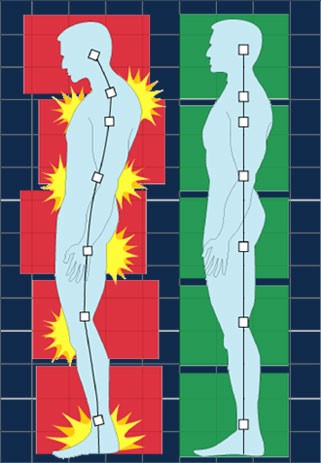|
Maintaining the health of your spine is crucial for your overall well-being. The spine plays a vital role in your body, supporting your frame, enabling movement, and protecting the central nervous system. Learning how to keep your spine healthy and improve spinal health can significantly enhance your quality of life by preventing back pain and other related ailments. Here, we’ll cover what causes spinal pain and list several simple steps that anyone can incorporate into their daily routines to help keep their spines healthy. Common Causes of Spinal PainIf you’re reading this blog, chances are you’re either currently experiencing or have experienced back and neck pain. Understanding the common causes of spinal pain is essential in preventing and managing back issues. Below, we’ve listed some of the most common causes of back and neck pain. Note that this list does not cover all possible causes, nor is it meant to diagnose the cause of any pain you may be experiencing. Always consult with a physician to properly diagnose any health concerns you have. Poor PosturePoor posture is a leading cause of back pain. Slouching or maintaining any unnatural position for extended periods can strain the muscles and put excess pressure on the spine. Over time, this can lead to structural changes in the spine, resulting in persistent pain and discomfort. Physical Strain and OveruseRepetitive activities or overexertion can lead to muscle strains or ligament sprains, which are common causes of lower back pain. Activities that might cause this include lifting heavy objects improperly, sudden awkward movements, or prolonged physical labor. Sedentary LifestyleA lack of regular physical activity can weaken the muscles that support the spine, leading to poor posture and increased vulnerability to injuries. A sedentary lifestyle can also contribute to the onset of obesity, which puts additional stress on the spinal structures. AgingAs we age, our spines go through natural degenerative processes. The discs between the vertebrae can lose hydration and elasticity, known as disc degeneration, which can reduce their ability to cushion the vertebrae and absorb shock. Osteoarthritis is also common in older adults, leading to pain and stiffness in the spine. Traumatic InjuriesAccidents, such as falls, sports injuries, and car accidents, can cause severe damage to the spine. These injuries can include fractures, dislocations, or severe sprains that impact spinal alignment and function. Medical ConditionsCertain medical conditions can directly or indirectly lead to back pain. These include scoliosis, a curvature of the spine; osteoporosis, which can lead to fractures; and various forms of arthritis that affect the spine's mobility and structure. Everyday Steps to Improve Your Spinal IntegrityUnderstanding these common causes of spinal pain can help you take preventive measures and seek appropriate treatment early. Now, let's explore some everyday steps you can take to maintain and improve your spinal health. Engage in Regular Light ExerciseContrary to popular belief, you don't need intense, heavy workouts to benefit your spine. Regular light exercise can significantly enhance spinal health. Start your day with simple stretches each morning to awaken your body and increase blood flow. Incorporate basic back and core strengthening exercises into a 15 to 20-minute daily routine. Consistency is key—not the intensity of the workouts. Walking is particularly beneficial for the spine. It strengthens your core and leg muscles while improving your flexibility. Next time you need a few items from the store, consider walking instead of driving. Or try extending your dog’s walk by an extra block. These small changes can make a big difference in maintaining your spinal health. Monitor and Improve Your PostureAs we’ve already explored, your posture has a profound impact on spinal health. Investing in an ergonomic chair can provide crucial spinal support, especially if you have a desk job or a sedentary lifestyle. Make it a habit to stand up and stretch every hour. Incorporating a standing desk into your workspace can also encourage you to alternate between sitting and standing, reducing the strain on your spine. When sitting, make sure your feet are flat on the floor and your back is aligned against the back of the chair. Avoid slumping or leaning forward, and adjust your workstation so that your monitor is at eye level and your arms can comfortably reach your keyboard. Update Your Sleeping ArrangementsThe quality of your mattress and pillows can significantly impact your spinal health. A good mattress supports the natural curve of your spine, reducing the risk of waking up with back pain. Replace your mattress approximately every seven years or sooner if you notice signs of wear or if you're not sleeping well. Choose a pillow that keeps your head aligned with your spine; the wrong pillow can lead to neck pain. Sleeping position matters too. The best positions for spinal health are on your back or side. If you sleep on your side, placing a pillow between your knees can help maintain proper alignment of your hips and lower spine. Stay HydratedHydration is essential for maintaining the elasticity and fluidity of the tissues in and around your spine. Drink plenty of water throughout the day to help prevent discs in your spine from becoming brittle and susceptible to injury. Maintain a Healthy WeightExcess weight can put additional pressure on the spine, leading to pain and other health issues. Maintaining a healthy weight through diet and exercise can reduce this pressure and improve overall spinal health. Practice Proper Lifting TechniquesImproper lifting can cause significant strain on your spine. Always lift with your knees and keep the object close to your body. Avoid twisting your torso while lifting to prevent injury. Manage StressStress can lead to muscle tension, particularly around the neck and back. Incorporate stress management techniques such as yoga, meditation, or deep breathing exercises into your daily routine to help relieve tension. See A ChiropractorRegular visits to a chiropractor can play a crucial role in maintaining spinal health. Chiropractors are skilled in musculoskeletal health and can help detect and treat issues before they become serious. Regular chiropractic care provides preventative maintenance for the spine, keeping it aligned and functional.
If you’re new to chiropractic care, consider scheduling an initial evaluation. Even if you don’t currently experience back pain, a chiropractor can assess your spinal health and recommend adjustments or exercises tailored to your needs. When people think of chiropractic care, they often associate it with back and neck pain treatment. However, chiropractic care offers a wide range of benefits that extend beyond just spinal issues. The body is a complex and interconnected system, and chiropractic treatments, which focus on relieving stress on the central nervous system and vertebrae, can address various health concerns. Here, we will explore ten conditions that you might not have realized can be treated effectively with chiropractic care. Let’s get cracking! Understanding Chiropractic CareBefore diving into the specific conditions, it is essential to understand the foundational principles of chiropractic care. Chiropractors use manual adjustments and manipulations to correct misalignments in the spine, known as subluxations. These adjustments aim to improve the function of the nervous system, reduce pain, and promote the body's natural healing processes. By addressing the root cause of health issues, rather than just treating the symptoms, chiropractic care can offer long-term relief and improve overall wellness. Ten Conditions Chiropractors TreatAs previously mentioned, chiropractic care is not just for treating back and neck pain. Here are ten conditions chiropractors can treat, offering unexpected benefits for your overall health. 1. Headaches and MigrainesMany people are unaware that chronic headaches and migraines can be related to spinal health. Subluxations can cause or exacerbate headaches by affecting the central nervous system. These misalignments can lead to nerve pain and tension in the neck and temples, resulting in tension headaches. Chiropractic adjustments can alleviate these issues by realigning the vertebrae, reducing nerve irritation, and improving blood flow. This can lead to immediate improvement or complete relief from headaches. Regular chiropractic care can also help prevent the recurrence of headaches by maintaining proper spinal alignment and reducing stress on the nervous system. 2. SciaticaSciatica is a condition characterized by pain that radiates along the sciatic nerve, which runs from the lower back down through the buttocks and legs. It is often caused by nerve compression in the spine, lumbar subluxations, herniated discs, pregnancy, or tumors. Sciatica can result in pain, numbness, and a pins-and-needles sensation in the affected areas, typically on one side of the body. Chiropractic care offers various treatments that can effectively alleviate the pain associated with sciatica. These treatments focus on relieving tension on the nerves and muscles, reducing inflammation, and promoting the body's natural healing processes. Techniques such as spinal adjustments, physical therapy exercises, and lifestyle modifications can all contribute to relieving sciatica symptoms. 3. Digestive ProblemsDigestive issues such as constipation, irritable bowel syndrome (IBS), and heartburn can be frustrating and challenging to manage. While these conditions are often addressed through dietary changes and medications, chiropractic care can also significantly improve digestive health. The nervous system controls many bodily functions, including digestion, and spinal misalignments can disrupt this process. Chiropractic adjustments can help promote self-healing by correcting spinal misalignments that may impede the function of the digestive organs. By improving nervous system function and reducing stress on the spine, chiropractic care can enhance the body's ability to process food and eliminate waste more effectively. Patients often report improvements in their digestive symptoms after receiving regular chiropractic treatments. 4. Joint PainJoint pain can be caused by various factors, including arthritis, injury, or overuse. It can affect any joint in the body and lead to discomfort, inflammation, and reduced mobility. Chiropractic care can help alleviate joint pain by improving joint function, reducing inflammation, and enhancing mobility. Through spinal adjustments, soft tissue therapy, and specific exercises, chiropractors can target the root causes of joint pain and provide lasting relief. Regular chiropractic care can also help prevent further joint issues by maintaining proper alignment and function. 5. Sleep DisordersSleep disorders can significantly impact overall health and quality of life. Many sleep issues are related to physical discomfort, stress, and poor posture. Misalignments in the spine can contribute to these problems by causing pain and disrupting the nervous system's function. Chiropractic adjustments can help improve sleep by reducing pain and stress, improving spinal alignment, and enhancing overall relaxation. Patients often report better sleep quality and fewer sleep disturbances after receiving chiropractic care. Chiropractors can also provide advice on proper sleep positions and supportive mattresses to further enhance sleep quality. 6. High Blood PressureHigh blood pressure, or hypertension, is a common condition that can lead to serious health issues if left untreated. Stress and poor nervous system function can contribute to elevated blood pressure levels. Some studies suggest that chiropractic care can help lower blood pressure by reducing stress and improving nervous system function. Chiropractic adjustments can support healthy blood pressure levels by addressing spinal misalignments and promoting overall wellness. Regular chiropractic care, combined with lifestyle changes, can be an effective approach to managing hypertension. 7. AsthmaAsthma is a chronic respiratory condition characterized by inflammation and narrowing of the airways. While it is typically managed with medication, chiropractic care can also improve respiratory function. Chiropractic adjustments can help improve respiratory function by ensuring proper alignment of the spine and ribcage. This can reduce stress on the nervous system and enhance the body's ability to manage asthma symptoms. Patients with asthma often report better breathing and fewer asthma attacks after receiving chiropractic care. 8. Anxiety and DepressionAnxiety and depression are mental health conditions that can significantly impact a person's quality of life. The nervous system plays a crucial role in regulating mood and emotional well-being. Chiropractic care can help improve mental health by reducing physical stress and promoting overall relaxation. Chiropractic adjustments can support emotional well-being by addressing spinal misalignments and enhancing nervous system function. Patients often report reduced anxiety and improved mood after receiving chiropractic care. Additionally, chiropractors can provide guidance on lifestyle changes and stress management techniques to further support mental health. 9. Posture ProblemsPoor posture can lead to various health issues, including back pain, neck pain, and reduced mobility. It can also contribute to the development of chronic conditions over time. Chiropractors can help improve posture by correcting spinal misalignments, providing exercises to strengthen the muscles supporting the spine, and offering ergonomic advice. Regular chiropractic care can help maintain good posture and prevent the negative health effects associated with poor posture 10. ArthritisArthritis is a condition characterized by inflammation of the joints, leading to pain, stiffness, and reduced mobility. It can affect people of all ages and significantly impact their quality of life. Chiropractic care can help manage arthritis symptoms by improving joint function, reducing inflammation, and enhancing mobility. Through spinal adjustments, soft tissue therapy, and specific exercises, chiropractors can relieve arthritis pain and improve overall joint health. Regular chiropractic care can also help prevent further joint damage and maintain an active lifestyle. Discover the Benefits of Chiropractic CareIf you or a loved one are experiencing any of the conditions mentioned in this blog post, chiropractic care could be the answer to long-term wellness. The benefits of chiropractic treatments extend far beyond just back and neck pain, offering relief for a wide range of health issues. By addressing the root cause of these problems, chiropractic care promotes natural healing and improves overall quality of life.
At Petrak Family Chiropractic, we are dedicated to helping our patients achieve their health goals through personalized and compassionate care. Schedule a consultation today to get started on the road to a healthier, more vibrant life. Chiropractic care is renowned for its effective, non-invasive, and drug-free approach to alleviating back and neck pain, affirming its place as a cornerstone of contemporary health care. The beauty of chiropractic lies in its versatility—beyond the commonly treated ailments, it also offers proven solutions for a diverse array of health issues such as headaches, migraines, sports injuries, whiplash, sciatica, fibromyalgia, scoliosis, and even knee and ankle discomfort. This holistic approach addresses immediate pain and contributes to long-term health and well-being. However, the effectiveness of chiropractic care hinges on understanding the various specialties and techniques that make up its broad spectrum of treatments. Each patient presents a unique set of health needs and challenges, which is why chiropractic professionals employ a tailored approach, integrating different specialties and advanced techniques into their practice. In this blog post, we will explore the various types of chiropractic specialties—ranging from massage therapy and physiotherapy to sports therapy and pediatric care. Additionally, we delve into the distinct chiropractic techniques and adjustments, such as the diversified technique, Thompson Drop-Table, and the Activator Method, illustrating how each contributes uniquely to patient care. Read on to understand how these specialties and techniques can enhance your health and improve your quality of life. Exploring Types of Chiropractic SpecialtiesChiropractic care encompasses a wide range of specialized treatments, each designed to address specific health concerns and patient demographics. These specialties are developed over years of clinical practice and research, allowing chiropractors to extend their care beyond general spinal adjustments to meet the diverse needs of their patients. From enhancing athletic performance to supporting child development and easing the physical strains of pregnancy, chiropractic specialties provide targeted, effective solutions. Here, we explore some of the key chiropractic specialties that demonstrate the adaptability of chiropractic care and its capacity to improve various aspects of health across different stages of life. Massage TherapyMassage therapy plays a pivotal role in the realm of chiropractic specialties. Far from merely serving as a method for relaxation, it significantly enhances the recovery process from injuries, improves range of motion—particularly in aging individuals—and augments the overall effectiveness of chiropractic treatments. By alleviating stress, relaxing muscles, and complementing spinal adjustments, massage therapy offers a dual benefit of therapeutic relief and sensory pleasure. Physiotherapy and RehabilitationPhysiotherapy and rehabilitation are integral components of chiropractic care, aimed at amplifying the benefits of chiropractic adjustments. This specialty not only focuses on recovery from injuries but also empowers patients to actively participate in their health journey. Customized exercises and stretches are often prescribed, enabling patients to continue improving outside of clinical settings. This approach underscores the importance of incremental progress, which is essential for recovery and long-term mobility. Sports TherapySports therapy is a specialized branch of chiropractic care designed to address the physical demands and injury risks associated with sports. This specialty emerged from chiropractic's profound impact on alleviating acute back pain caused by sports injuries. Today, sports therapy not only aids in rapid recovery but also plays a preventive role by enhancing athletic performance and reducing the risk of future injuries. Pediatric CareChiropractic care is not only safe for children but highly beneficial, especially before and during puberty—a critical period of rapid bone growth. Pediatric chiropractic ensures proper spinal alignment and development, which can have a lasting impact on a child's health and well-being. Trained to address the unique needs of infants, children, and teenagers, chiropractors specializing in pediatric care are dedicated to the foundational health of younger patients. Pregnancy CareThe benefits of chiropractic care extend into pregnancy, offering relief from common discomforts such as nausea, dizziness, back and neck pain, and morning sickness. Specializing in prenatal chiropractic, practitioners focus on pelvic alignment to facilitate a smoother birthing process, potentially shortening labor duration and reducing the likelihood of complications like breech births and the need for cesarean sections. The Benefits of Chiropractic SpecialtiesEach chiropractic specialty is designed to address specific health issues and patient needs, creating a tailored approach to health care that promotes optimal well-being. Here’s how these specialties benefit various groups:
Understanding Different Chiropractic Techniques and AdjustmentsIn addition to the various specialties, chiropractic care involves various techniques and adjustments tailored to individual needs. These techniques are designed to improve spinal alignment, relieve pain, and enhance overall bodily function. Here is an overview of some commonly employed chiropractic techniques. Diversified TechniqueThe diversified technique is perhaps the most well-known and widely used chiropractic method. It involves precise manual thrusts focused on restoring proper movement and alignment to the spine. This technique is particularly effective in improving joint mobility and alleviating pain. Thompson Drop-Table TechniqueThe Thompson technique utilizes a specialized treatment table featuring several segments known as drop pieces. These segments can be raised a fraction of an inch so that upon application of a quick thrust, the table drops. This drop helps enhance the motion of the adjusted area, making the adjustment less forceful and more comfortable for the patient. Gonstead AdjustmentNamed after its developer, Dr. Clarence Gonstead, this technique addresses misalignments and dysfunction with great precision and meticulous attention to detail. The Gonstead adjustment is known for its thorough evaluation process, which uses visual assessment, full spine X-rays, and a temperature-sensitive instrument to detect spinal issues. Activator MethodThis method uses a small, hand-held instrument called the Activator Adjusting Instrument to deliver a gentle impulse force to the spine to restore motion to the targeted spinal vertebra or joint. Its gentle nature makes it suitable for patients who may not be comfortable with the manual thrusts of more traditional adjustments. The Palmer MethodDeveloped by the founder of chiropractic, D.D. Palmer, this method involves a comprehensive approach that includes various techniques to adjust the misalignments in the spine. The Palmer Method is known for its holistic view, considering the entire body and its function in relation to the spine. Sacral Occipital Technique (SOT)SOT is a method of chiropractic care that focuses on the relationship between the sacrum (base of the spine) and the occiput (base of the skull). It involves specialized wedge-shaped blocks that are placed under specific areas of the pelvis, facilitating corrections to the sacral area and improving cerebral spinal fluid flow. The Toggle Recoil TechniqueThis technique involves a quick, light touch on a specific area of the spine followed by a rapid release, which allows the body to "recoil" back to its natural state of alignment. It is particularly useful for adjusting the upper cervical spine and is renowned for its precision and gentle application. Read more: 7 Types of Chiropractic Methods for Pain Relief Discover How Chiropractic Care Can Transform Your LifeThe various types of chiropractic specialties and advanced techniques offer comprehensive solutions that cater to specific health needs across all age groups. By understanding and choosing the proper chiropractic care, individuals can significantly improve their health, wellness, and quality of life. Whether you are seeking relief from chronic pain, support through pregnancy, preventive care for children, or enhanced athletic performance, chiropractic specialties provide a foundational approach to health that goes beyond temporary fixes, aiming for long-term health and vitality.
We invite you to experience the benefits of personalized chiropractic care firsthand. Contact Petrak Chiropractic today for a consultation to discuss how our tailored chiropractic services can meet your health needs and help you achieve your wellness goals. Athletes understand that what they do is very physically demanding, and there’s a high potential for injury every time they do it. Running, jumping, swimming, fighting, tackling, and exerting your body to its fullest potential takes a toll and often results in sprains, strains, and muscle tears. When any of these present themselves, it’s easy to turn to painkillers to treat the pain. But pain pills present health hazards in their own right, plus they only treat the symptoms — they don’t tackle the root of the issue. This is why sports chiropractic is so beneficial to athletes. Not only does it help the body heal after injuries occur, but it also improves flexibility, range of motion, and optimizes the body to prevent future injuries from occurring in the first place. Why Choose a Sports Injury Chiropractor?Sports injury chiropractors possess an advanced understanding of the physical demands of sports. This expertise allows them to identify and treat common injuries in the athletic realm, from acute injuries like sprains and strains to chronic issues such as tendonitis or overuse injuries. Their training is tailored to address the specific needs of athletes, ensuring treatments are effective and conducive to enhancing athletic performance. A Holistic Approach to Athlete WellnessUnlike traditional medical treatments that often focus solely on symptom relief, sports injury chiropractors take a holistic approach to an athlete's health. This encompasses not just the physical aspects of sports injuries but also considers nutritional, lifestyle, and psychological factors that can impact recovery and performance. By addressing these broader aspects, chiropractors help athletes achieve optimal health and well-being, which in turn can enhance their performance. Customized Rehabilitation and Recovery PlansUnderstanding that each athlete is unique, sports injury chiropractors create customized rehabilitation plans that cater to individual needs, goals, and the specific demands of their sport. These plans may include a combination of chiropractic adjustments, soft tissue therapies, physical therapy, exercises, and advice on injury prevention strategies. The goal is to expedite the healing process and ensure that the athlete returns to their sport stronger and more resilient against future injuries. Performance Optimization and Injury PreventionBeyond recovery, sports injury chiropractors focus on optimizing an athlete's performance and preventing future injuries. This is achieved through regular assessments of an athlete's biomechanics, providing adjustments and interventions that enhance flexibility, strength, and overall physical function. By ensuring the body is properly aligned and functioning at its peak, chiropractors help athletes improve their performance metrics, such as speed, agility, and endurance. Collaborative Care and EducationA sports injury chiropractor often works as part of a multidisciplinary team, collaborating with coaches, physical therapists, and other healthcare professionals to provide comprehensive care. This collaborative approach ensures that all aspects of an athlete's recovery and performance enhancement are addressed. Additionally, chiropractors educate athletes on proper body mechanics, posture, and techniques to reduce the risk of injury during training and competition. What are Common Sports Injuries?From the novice runner to the professional athlete, the physical demands of sports can lead to a range of injuries that, if not properly addressed, can sideline even the most dedicated participants. Understanding the types of injuries that commonly occur is the first step in developing effective prevention and treatment strategies. Here, we highlight some of the most frequent sports injuries, shedding light on their causes, implications, and the pivotal role chiropractic care plays in addressing them.
The Dual Role of Chiropractic Care for Sports InjuriesChiropractic care stands out for two key reasons: its ability to heal and its capacity to prevent injuries. It's a misconception that its benefits are limited to post-injury care. On the contrary, regular chiropractic sessions contribute to maintaining a limber body, preserving range of motion, and strengthening the muscles and spine. This proactive approach significantly reduces the risk of future injuries. However, it's crucial to recognize that chiropractic care is not a one-time fix but a journey toward ongoing health and resilience. Regular visits, combined with prescribed at-home exercises, enhance the body's healing process and fortify it against potential injuries. It's essential for anyone seeking chiropractic treatment, especially athletes, to communicate any recent injuries, surgeries, or health conditions to their chiropractor. Contact an Experienced Sports ChiropractorFor athletes contemplating chiropractic care, the first step is reaching out to a professional who can guide you toward a healthier, more resilient version of yourself. Whether you're recovering from an injury or looking to prevent one, a sports injury chiropractor is your ally in achieving optimal health and performance.
Chiropractic care offers a holistic and practical approach to dealing with sports injuries, transcending the limitations of conventional pain management strategies. By focusing on the underlying issues, promoting healing, and preventing future injuries, chiropractic care empowers athletes to maintain peak physical condition and pursue their passions with confidence. At Petrak Family Chiropractic, we're committed to guiding our clients through their recovery journeys and beyond, ensuring that every athlete can perform at their best, free from the constraints of injury. Reach out today to learn how we can support your health and athletic goals. Gardening and yard work can be cathartic and rewarding. But the wear and tear on your body from hauling wheelbarrows of mulch, carrying bags of yard clippings, and planting flowers can take a toll, so it’s essential to warm up properly and take simple precautions to avoid back injury. Can Gardening & Yard Work Cause Severe Lower Back Pain?While gardening offers an abundance of benefits, it's important to recognize the potential risk it poses to your lower back and spinal health. The combination of repetitive bending, twisting, and heavy lifting, often paired with sitting in awkward positions like kneeling for prolonged periods of time, can put significant stress on your lower back and spine. The added stress may lead to muscle strain, severe pain, or other injuries if proper precautions are not taken. Gardening and yard work can worsen pain in pre-existing conditions like arthritis or sciatica due to added stress. Therefore, it's essential to prioritize proper form, listen to your body, and consult your doctor if you have any concerns about back pain from gardening or yard work. How to Avoid Back Pain After GardeningFollow these tips next time you garden to decrease your risk of injury and ensure your hobby remains enjoyable and safe for your back. Stretch Before GardeningStretching before rigorous or prolonged physical activity is crucial. Generally speaking, yard work can take anywhere from a few hours to a whole day. That’s a long time to remain physically active. So whether you’re hauling leaves or grass clippings, pushing a lawnmower, planting flowers, or trimming trees and hedges, it’s important to prepare yourself to avoid injury. Try stretches that focus on your neck and back. Even 5 to 10 minutes of stretching a day can significantly impact your health. Take Regular BreaksWhen you dedicate an entire day to yard work, take breaks every so often. Cool down inside, grab a glass of ice-cold water and relax for 5 or 10 minutes before resuming. Being so focused on the task at hand can make time fly, but try to set the alarm on your phone every hour or so to take a break to re-hydrate and give your body some rest. It’s also beneficial to break monotonous tasks into segments. Spending hours on end hunched over plants will be rough on your spine. Instead, try switching activities every 20 minutes or so and come back to finish them later. Repetitive, strenuous motions should be avoided as they can negatively affect your joints and muscles. Proper Lifting TechniqueGardening frequently involves lifting heavy and awkwardly shaped objects. To minimize the risk of back pain or injury, it is crucial to lift with proper form. Always bend at your knees and lift with your legs, not your back. This engages your stronger leg muscles and reduces strain on your back. If an item feels too heavy or awkward to lift safely alone, don't be afraid to ask for help or use a cart or wheelbarrow to alleviate some of the stress and protect your back. Use Tools to Help YouThere are many gardening tools designed to help your posture and make you more comfortable while gardening. For example, use a long-handled rake that matches your height to avoid hunching over. Invest in knee pads for kneeling comfort, and consider ergonomic hand tools that reduce strain. The right tool can make all the difference. Listen to Your BodyIt's important to be able to recognize your physical limitations when gardening. If a task feels uncomfortable, stop and adjust. If your muscles are feeling fatigued, take a break. Pushing through the tiredness only increases your risk of injury. By listening to your body, you can prevent injury. Take Proper Care of Your Spine and BackGetting regular chiropractic adjustments is a great way to maintain good spinal health, especially during the warmer seasons. Between outdoor yard work and general increased outdoor activity in the summer, it’s important to ensure that you don’t injure yourself. Visiting a chiropractor will help you become more flexible and protect your joints from the natural wear and tear of doing yard work and other strenuous physical activities. At Petrak Family Chiropractic Center, your physical health is our number one priority. We’ll create an individualized treatment regimen custom-tailored to improve your flexibility, balance, range of motion, joint and spinal health, and more. Get in touch to get started. Daniel David Palmer (aka D.D. Palmer) is widely known as the founder of chiropractic care. He opened the very first school of chiropractic in 1897 where he taught his healing techniques and eventually expanded the college to multiple cities all while raising awareness of the benefits of chiropractic. Since then, chiropractic has spread far and wide as a viable non-invasive treatment for many ailments. This growth prompted the development of diverse techniques to address specific needs. In this blog, we will discuss 7 types of chiropractic methods frequently used today. The Palmer Method of ChiropracticThe Palmer Method, named after D.D. Palmer, focuses on misalignments of the upper cervical spine, particularly the atlas (the first vertebra at the base of the skull). It centers on the belief that misalignment of the atlas can disrupt nerve communication and lead to other health problems throughout the body. The Palmer method often operates using a "hole-in-one" technique. This involves using X-rays to pinpoint the exact position of the atlas. Then, through gentle manipulations of the head and neck, the chiropractor aims to guide the atlas back into its ideal alignment. The Gonstead TechniqueThe Gonstead Technique is centered around the idea that the body’s foundation is the pelvic girdle. When this structure is normal, balance and stability are also normal. However, if any of the vertebrae become misaligned, changes will be prevalent throughout the whole body. The original philosophy behind this method is to find the misalignment, correct it, and leave it be unless it causes further problems. While focusing on the spine, Gonstead practitioners consider overall health and may recommend lifestyle changes or complementary therapies. The Diversified Chiropractic TechniqueOne of the most common chiropractic methods used in modern practices, the Diversified Technique, employs the techniques you might imagine when you think of the term “chiropractic.” The chiropractor uses their hands or instruments to apply a quick, controlled thrust to a specific joint with restricted movement. Its objective is to restore proper mobility and range of motion via “high velocity and low amplitude” thrusts within each joint that’s affected. The Thompson Drop TechniqueThis technique involves something called the Thompson Drop Table, a specialized treatment table that has segments that “drop” with the portion of the body being treated during high velocity, low amplitude thrusts. The table facilitates joint movement and is considered a gentle healing technique. The Activator MethodThe Activator Method is the 2nd most common technique used in chiropractic care. It’s unlike traditional spinal manipulation because it uses a small tool called the “Activator Adjusting Instrument.” This tool delivers low-force, high-speed adjustments to a specific, single, targeted vertebra. The activator method emphasizes precise targeting and claims to be gentler than traditional manual adjustments, making it potentially suitable for individuals who prefer a less forceful approach. The Sacro-Occipital TechniqueThe Sacro-Occipital technique (SOT) is a comprehensive chiropractic method that focuses on restoring balance and function to the neuromusculoskeletal system, particularly focusing on the relationship between the sacrum (the triangular bone at the base of the spine) and the occiput (the bone at the back of the head). It came about when an engineer, Major Bertrand DeJarnette, suffered a major injury and received chiropractic treatment. He applied his engineering expertise to chiropractic, stressing the importance of indicators and patterns within the body, acknowledging that pain in one area could be caused by misalignments in another. Using this method allows chiropractors to know when spinal corrections are not enough so they can employ other methods. The Toggle Recoil TechniqueToggle Recoil is a chiropractic method invented by BJ Palmer, the son of D.D. Palmer, in 1910. It corrects the upper cervical vertebra (in the neck) without twisting or bending the neck and is considered a gentle healing technique. The use of a drop table is required so the chiropractor can use minimal force with extreme precision and maximum results. Schedule a Chiropractic AppointmentDr. Petrak was trained at the Palmer College of Chiropractic and uses the Palmer Method every day to help patients live healthier and happier lives. Contact us today to schedule an appointment!
How to Prevent Back Pain While Traveling Traveling often involves extended periods of sitting, which can take a toll on your spine, even if you don't currently experience chronic back pain. But whether you're managing existing back issues or simply interested in preventative measures, there are ways to mitigate discomfort and protect your spine on long journeys. This blog explores 5 key tips to keep your spine healthy and prevent back pain from flaring up during travel. 1. Lift Your Luggage SafelyThe physical tolls of lugging heavy baggage often leads to injury. In 2017 alone, the U.S. Consumer Product Safety Commission reported over 85,000 emergency room visits, doctor appointments, and clinic trips due to luggage-related mishaps. Before lifting any luggage, take a second to check your posture. Keep your back straight, bend at the knees, and lift with your legs, not your back. Every time you need to lift heavy luggage, make sure you carry it as close to your body as possible, distribute the weight evenly, and avoid twisting the lower back while carrying heavy bags. 2. Check Your PostureIdeally, you should sit up straight with your head back, both feet flat on the ground, and knees bent at a 90-degree angle. This alignment eases strain on back muscles and your spine. Adapting awkward positions can lead to muscle tension and spinal imbalances, so prioritize comfort and proper support throughout your journey. 3. Use Props to Support Your SpineDuring travel, the seats generally do not provide the best support for your lower back or neck muscles. Consider using props for added support where needed. Neck pillows, foot rests, and lumbar support pillows are all excellent options to give your spine additional support and make you more comfortable during the long journey. If you do not have a lower lumbar support pillow, roll up a jacket/sweater and put it behind your lower back for improvised, extra support. 4. Get Up and Move As Often As PossibleStaying sedentary in an uncomfortable seat for too long isn’t good for the vertebrae. If it’s not too disruptive to your aisle-mate, during long flights/train/bus rides take the opportunity every 30–45 minutes to get up and walk around and stretch a bit. If you are driving, be sure to stop at rest areas and take a short walk as often as you can. The more you can keep your spine mobile, the better you will feel. 5. Stretch RegularlySitting on long journeys tightens muscles and stresses your spine. Regular stretches combat this by boosting flexibility, reducing stiffness, and strengthening supporting muscles, keeping your back and spine healthy and ready for any travel adventure. Focus on hamstrings, neck, and core stretches to help release muscle tension and improve blood flow to the spine. For more information on this topic, check out our blog, ‘Daily Stretches to Improve Your Health.’ Visit Petrak Family Chiropractic Center for Chronic Back PainTraveling for long distances normally means being sedentary in confined spaces for long periods of time. Be sure to take the proper precautions in order to prevent injuries to the spine. At Petrak Family Chiropractic Center, we will curate a personalized plan to help prevent and treat chronic back pain. Contact us today to schedule your free consultation. Is Chiropractic Safe for the Elderly?Many older adults have the mindset that it’s either too late in life for them to get help with their pain issues or that chiropractic care is harmful to their bodies. However, this is a huge misconception. Chiropractic care is helpful for people of all ages, even if you think it’s “too late.” Geriatric chiropractic care centers on providing gentle, customized treatment plans that address the unique needs of seniors. Chiropractors carefully consider any age-related musculoskeletal concerns, with the overarching goal of improving overall well-being. This approach aims to alleviate pain and provide much-needed relief to seniors, enabling them to live fuller, more comfortable lives. Gentle and Effective Pain Relief For SeniorsThe vast majority of chiropractic patients make their appointments because of pain issues. Research from the CDC shows that 39% of Americans have experienced back pain within the last 3 months, making it one of the most prevalent pain sites. Take into account that our bodies become more fragile as we age, and it’s no surprise that pain and chronic conditions such as arthritis have become more common. Oftentimes for older adults, daily tasks become more difficult, pain becomes prevalent, and in many cases, multiple medications are taken daily. But it doesn’t have to be this way. Geriatric chiropractic care offers a non-invasive treatment for preventative care and pain management. Chiropractors custom tailor each of their treatments according to the needs of the individual. This means that if they need to be gentle, they’ll be gentle. For example, when working with patients who have arthritis, chiropractors may need to forgo certain techniques and implement others. A geriatric chiropractor’s job is to ensure treatment — even if it is supplementary working with other types of pain remedies. Chiropractors will fix the subluxations that affect the spine, relieving pain and inflammation using drug-free and non-invasive methods. Reduce Fall Risk by Improving Range of Motion, Coordination, and BalanceBecause bones grow fragile and muscles become weaker as we age, it only comes naturally that range of motion decreases and balance becomes harder to maintain. According to the CDC, approximately 3 million geriatric patients are treated for fall injuries in emergency departments, and 1 in 5 of those falls lead to serious injury such as traumatic brain injuries or hip fractures. Geriatric chiropractic care aims not only to relieve pain but to strengthen the muscles around the spine by prescribing simple daily stretches and exercises. These exercises don’t take long to complete, but will go a very long way in improving balance and reducing fall risk. Since the exercises strengthen the muscles, they also help to neutralize any severe injuries that come with falling down. Mitigate the Impact of Chronic IllnessesA study titled “Chiropractic for the Elderly” was done in the Journal called Topics of Clinical Chiropractic. In it, they found senior citizens showed a decrease in the severity of arthritis in those who had received regular chiropractic care as they aged. Other findings included:
It’s never too late to start improving your range of motion, relieving pain, or decreasing the severity of your chronic condition. Chiropractic aims to strengthen your spine and increase healthy activity in general. So if you’re ready to start on the path to a healthy you, contact Petrak Family Chiropractic Center today to schedule your free consultation! Chiropractic care is concentrated on correcting spinal misalignments to improve and preserve a healthy nervous system. The practice offers both physical and emotional benefits, with chiropractic adjustments alleviating physical symptoms and contributing to improved mental well-being. In this blog post, we'll discuss the connection between chiropractic care and anxiety, exploring how this holistic approach can make a difference. What is Anxiety? How Does It Relate to Chiropractic?Anxiety is a normal and often healthy emotion. However, regularly feeling high levels of worry, nervousness, or fear interferes with daily life and can manifest in a variety of ways, both physically and emotionally. Some common symptoms of anxiety include:
With chronic anxiety, your body is put in a constant state of fight or flight which activates and overworks your nervous system. Chiropractors use a holistic approach to health rooted in the relationship between the spine and the nervous system. While chiropractic care is not a cure for anxiety, it can be an effective treatment to help manage anxiety symptoms and improve overall well-being. How Can Chiropractic Care Benefit Mental and Emotional Health?The physical and emotional benefits of chiropractic care are closely linked. By correcting spinal misalignments, also known as subluxations, chiropractors can improve nerve function, reduce physical symptoms and ailments, and improve mental health. Chiropractic care helps to reduce anxiety in several ways, including:
Many patients with chronic pain find that chiropractic care helps to improve their daily lives and reduce stress levels. When we are in pain, our bodies release stress hormones, which can lead to anxiety and depression. Chiropractic care helps break this cycle by reducing pain and inflammation and promoting relaxation. Schedule Your Free Consultation at Petrak Family Chiropractic CenterTreatment is beneficial to everybody — children, adults, and even pregnant women. If you suffer from anxiety or stress caused by physical impairments, our team at Petrak Family Chiropractic Center is ready to help. We will work with you to create a regimen customized to fit your individual needs. There’s no need to let chronic pain affect your positive disposition. Give us a call or complete our contact form to get started!
Chiropractic adjustments are a great way to improve your overall health and well-being, but it can be intimidating to take the first step. In this article, we'll walk you through what to expect at your first chiropractic appointments so you can feel more prepared and confident. We'll explore how to prepare for your first appointment, what happens during your initial consultation, and what ongoing treatment looks like. How to Prepare for a Chiropractor AppointmentYour first chiropractic appointment can be an exciting time, but it's also normal to feel a little nervous. Here are a few tips to help you prepare and make the most of your visit:
What to Expect During Your First Visit to the ChiropractorStep 1: Review Medical HistoryAs with any initial medical appointment, chiropractors will start by reviewing your health history. There are certain things they need to know about your physical condition that may alter how they administer treatment. For example, does your family have a history of genetic, physical, or medical complications? Have you had recent injuries? Have you had surgeries in the past? Are you pregnant? All of these factors are crucial to know before beginning chiropractic care. Step 2: Physical ExaminationAfter discussing your health history, expect to have a physical examination. During the initial exam, the chiropractor will evaluate a variety of factors, including:
This allows chiropractors to assess your unique needs and determine how best to treat you — it’s all dependent on why you considered chiropractic in the first place. If you have chronic aches and pains, they’ll find the source and the best way to relieve them. If you have a sports injury, they’ll need to thoroughly examine the injury site to determine a treatment plan. At Petrak Family Chiropractic Center, we have an on-site X-ray that we may use as an added benefit. What to Expect During Recurring Chiropractor AppointmentsStep 1: Discuss Treatment Plan and ProgressionAt Petrak Family Chiropractic Center, we start your second visit with a detailed overview of our findings from your initial appointment. This helps give you a better understanding of your personalized treatment plan and clarify the cause(s) of your discomfort. No patient is the same, so one size does not fit all. Treatment can vary from chiropractic spinal manipulation, massage therapy, physiotherapy and rehabilitation methods, or orthotic analysis. We want you to feel informed about your care, so we take the time to answer any questions you may have and make sure that you understand your treatment options. We also encourage you to provide feedback on your progress and any concerns you may have along the way. Step 2: Begin TreatmentOnce there is a clear understanding of your treatment plan and why we’re doing what we’re doing, we can begin treatment. Chiropractic care is both curative and preventive maintenance to the body so treatment is ongoing. We’ll schedule periodic appointments to check in on how you’re improving and how we can be helping stay on track. We will also go over steps you can take to improve your condition outside of our office including stretches, nutritional advice and exercise recommendations. We keep an open atmosphere, so any questions or concerns you may have about your treatment plan are more than welcome! If you’re ready to start taking charge of a healthier you, set up an initial appointment today!
|















